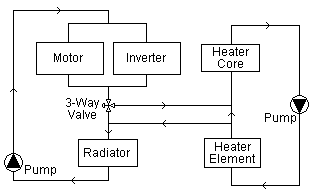Here's how I'd do it:

It's exactly identical to the presumed system the manual seems to describe, except there is a bypass and 3-way valve which has the ability to divert flow from the motor cooling loop into the cabin heating loop. The valve only opens when the fluid in the motor cooling loop is hot enough to contribute and only when heating is required. You wouldn't even need particularly fancy controls on the valve either: simple min & max setpoints (no modulating) would suffice for this.
It would add maybe $150 to the cost of the vehicle but would help in cold climate driving where heating would be a significant factor in power consumption. Provided, of course, the motor/inverter gets hot enough, soon enough. As turbo2ltr mentioned, the coolant system seems capable of running while charging, so that may help "pre-warm" the system.
=Smidge=

It's exactly identical to the presumed system the manual seems to describe, except there is a bypass and 3-way valve which has the ability to divert flow from the motor cooling loop into the cabin heating loop. The valve only opens when the fluid in the motor cooling loop is hot enough to contribute and only when heating is required. You wouldn't even need particularly fancy controls on the valve either: simple min & max setpoints (no modulating) would suffice for this.
It would add maybe $150 to the cost of the vehicle but would help in cold climate driving where heating would be a significant factor in power consumption. Provided, of course, the motor/inverter gets hot enough, soon enough. As turbo2ltr mentioned, the coolant system seems capable of running while charging, so that may help "pre-warm" the system.
=Smidge=
